Subscribers, I think this Post may first have been sent to some of you with no content. If so I’m sorry.
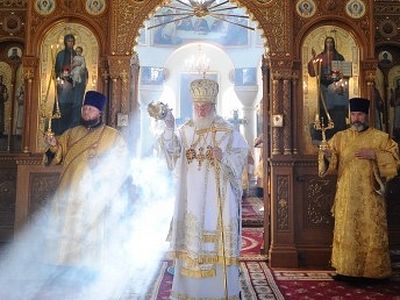
In case you want to review, last week I listed the previous Posts of this long series on the Liturgy.
 Especially today, I’ve taken much from Father
Especially today, I’ve taken much from Father Alexander Schmemann’s writings. You might want to read his books For the Life of the World and The Eucharist, published by Saint Vladimir’s Seminary Press: https://svspress.com/svs-press-books/ and also available from other sources.
Alexander Schmemann’s writings. You might want to read his books For the Life of the World and The Eucharist, published by Saint Vladimir’s Seminary Press: https://svspress.com/svs-press-books/ and also available from other sources.
The Blessing and Offering of the Holy Gifts
The Divine Liturgy has many purposes. The Pro-Anaphora came to its climax with our hearing the words of Christ in the Holy Gospel. Now the Anaphora takes us even higher.
As Father Schmemann pointed out, the first words of the Divine Liturgy (which sadly many Orthodox never hear, as they straggle in late) tell us where we’re headed: Blessed is the Kingdom of the Father and of the Son and of the Holy Spirit. The Liturgy takes us on a journey into the Kingdom of God, if we have eyes to see and hearts open to it. (And even if we don’t!) To experience Heaven on earth, earth lifted up into Heaven. We are here to join ourselves to Christ’s eternal Sacrifice at the Heavenly Altar, and to share in the Banquet in Heaven.
This is why the Liturgy has a series of symbolic entrances: First we entered individually into the church building and through the narthex entrance into the church proper. Then the Little and Great Entrances into the Altar carried us together in spirit further and further into God’s Kingdom till finally we arrived at the Holy of Holies, the Altar of God.
Posts 151 and 152 describe the Liturgy of Preparation: how the Holy Gifts of bread and wine are prepared and set apart by the Priest before each Divine Liturgy. The Bread, provided and offered by a member or family of the church, is called the Prosphoron/πρόσφορον or “offering”. (plural: Prosphora).
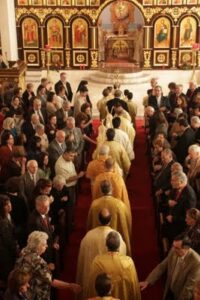 Saint George Greek Orthodox Cathedral, Greenville, South Catolina
Saint George Greek Orthodox Cathedral, Greenville, South Catolina
At the Great Entrance the Priest carried these Gifts through the congregation, mystically joining each of us and all of us to them. And so, as Saint Augustine wrote, “there are you on the plate; there are you in the chalice; there are you on the altar”.
Later, toward the beginning of the Anaphora proper, we join ourselves to the “action” on high. The Priest sang: Let us lift up our hearts. People: We lift them up unto the Lord. Priest: Let us give thanks (Greek ευχαριστίσωμεν, literally “let us eucharist”) to the Lord. From this comes the title which many Christians give to this whole service, and which Orthodox often use for Holy Communion itself: the Eucharist, the Thanksgiving.
The Priest now takes Bread and Wine as Christ commanded at the Last Supper. We Orthodox call these the Holy Gifts, our gifts to the Father. But first these were His gifts to us – the products of His seeds, His soil, His sun, His rain, His wheat, His grapes, which have been made into bread and wine by human work and ingenuity, which are also gifts of God. They symbolize the fundamentals of life, food and drink. Now they are our gifts to Him in return.
From the Basilica of Saint Mary (Antiochian) Orthodox Church, Livonia Michigan:
We stand at the Heavenly Altar, with our Lord and God Jesus Christ. The Priest faces liturgical east, not facing the people. That is, he stands as Christ did, who came and “stood with us” and died as a Man, with His people, and is still is with us in His glorified Body. He offers His eternal sacrifice to the Father, still “with us”.
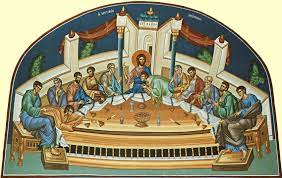
Icons by permission of Saint Isaac’s Skete at skete.com
The Priest describes how Christ first set these Gifts apart at His Last Supper: For when He was about to go forth to His voluntary and ever-memorable death, in the night in which He gave Himself up for the life of the world, He took bread in His holy and immaculate hands, and when He had shown it to You, the God and Father. and given thanks, and blessed it and hallowed.and broken it, He gave it to His holy disciples and apostles, saying: Take, eat. This is my Body which is broken for you, for the forgiveness of sins… This is my Blood of the New Covenant which is shed for you and for many for the forgiveness of sins.
“This is my Body. This is my Blood.” Orthodox do not see these words as the “moment of consecration”. For us they are chiefly a description and anticipation of what is happening.
What is happening? What did our Lord mean by these words? Christians have argued much about it.
Should we take them literally? Yes, of course. He didn’t say These are like my Body and Blood. He said “This is my Body. This is my Blood.”
Are the Bread and Wine “symbolic”? Yes, but not in the modern sense of the word. They are not only reminders. In the ancient sense, as someone wrote well in Orthodox Wiki: “To understand a symbol is to participate in the presence. Symbols are not mere illustrations, not are they a substitute of reality. They have the power and competence of manifesting God to men.” Rather like the American flag, which is only cloth, only a symbol, after all, but that symbol carries with it the “presence” of America.
Does this mean the Bread and Wine are changed chemically? No. But Orthodox have never tried to explain what does happen. We do not attempt philosophical explanations of divine things which are beyond us. I think we would almost agree with Queen Elizabeth I of England who reputedly said: “Christ was the Word that spake it, He took the bread and brake it, And what His word doth make it, That I believe and take it.” Do we need more explanation?
Here is how I understand Jesus’ words. (This is not dogma, only my opinion. Please correct me if I’m off base.) Christ is God who by “nature”, so to speak, has no human body. Then He took on a Body born of the Virgin Mary – a Body, a place where people could locate Him, through which He worked, teaching, healing, saving.
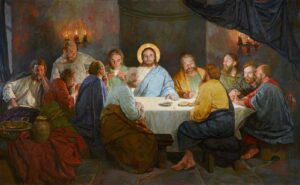 A.N.Mironov, 2010, at Creative Commons
A.N.Mironov, 2010, at Creative Commons
So now He sat at His Last Meal before His death. Next day His human Body would die, His Blood would be shed. After three days, He would rise again bodily, but after His Ascension He would no more be on earth bodily in His human form.
He took bread and said “This is my Body”. You will now find me here; I will now work through this. “This is my Blood” – my power, my life poured out for you. I will meet you here, strengthen you, save you through this Bread and Wine.
Both Saint Paul, in the earliest written account of His words (1 Corinthians 11:24-26), and also Saint Luke (Luke 12:19) say Christ said “This is my Body, given for you …Do this in remembrance of me.”
First, let’s look at that word “remembrance”. “Remembering” is a very inadequate translation. It suggests that here we are just thinking about Jesus. Forgive me for getting technical for a moment, but this is very important. The New Testament Greek word here is ἀνάμνησιν (anamnesin). Basil and Chrysostom use the word Μεμνημένοι (Memnimeni) which has the same root. Anamnesis meant more like “re-calling”, taken literally – to “call again”. It means here we re-call Christ to be with us.
 “My Body given for you.” Does this identify the Holy Bread with His death? Yes. The focus of His “giving” Himself for us was His sacrificial Crucifixion. But far more than that: In all Jesus did for us, He “gave” Himself for us – from the moment He took flesh in the womb of the Virgin till now. He and all His saving acts are accessible to us here.
“My Body given for you.” Does this identify the Holy Bread with His death? Yes. The focus of His “giving” Himself for us was His sacrificial Crucifixion. But far more than that: In all Jesus did for us, He “gave” Himself for us – from the moment He took flesh in the womb of the Virgin till now. He and all His saving acts are accessible to us here.
Therefore Saint Basil continues: Remembering His saving passion and life giving cross, His three day burial and resurrection from the dead, His ascension into heaven, and enthronement at Your right hand, O God and Father, and His glorious and awesome second coming.
Even His future second coming is here! for we are now in Heaven in the eternal “now” with Christ our God, where past and future are present. This is “cosmic”, all-encompassing – because Jesus Christ Himself is here.
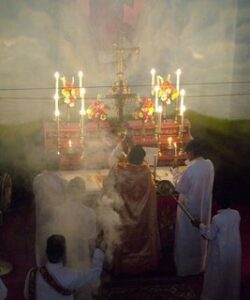 Malankara Syrian Orthodox Church of India
Malankara Syrian Orthodox Church of India
Now, united with Christ in His Sacrifice, we offer up all things to God the Father: our whole lives, the whole world. The Priest lifts up the holy Bread and Wine: Your own of Your own, we offer unto You in behalf of all and for all – offering it all up to God, losing it all in His glory: We praise You, we bless You, we give thanks to You, O Lord. and we pray unto You, O our God. We cling to nothing for ourselves, claim nothing for ourselves, no good deed upon earth, trusting only in God’s mercies and compassions which He has poured out on us.
Saint Basil calls the Holy Bread and Wine antitypes of the Body and Blood of Christ. An antitype is “something that is foreshadowed by a type or symbol, like a New Testament event prefigured by an antitype in the Old Testament”. I find this term confusing here, though it was commonly used in the early Church. (See, for example, an article “Antitype” by Reader John Nichiporuk.) Perhaps it means that Christ’s Last Supper was a prefiguring of this Liturgy? (If anyone can help me understand, please comment below.)
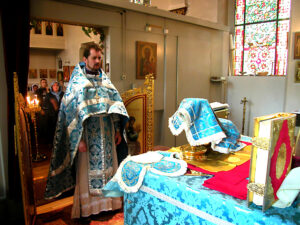
Ukrainian Orthodox Church, Dusseldorf, Germany
The Epiclesis
Now the direction of the Liturgy changes. So far it has been an offering up. But now… we pray and implore You…that Your Holy Spirit may descend upon us and upon these gifts…and hallow them. This is called the “Epiclesis” / ἐπίκλησις, the calling down of the Holy Spirit. This is a New Creation, the Holy Spirit again descending, “moving over the face of the deep” as in the first Creation. Genesis 1 Christ again becomes incarnate, embodied, as when the Holy Spirit first overshadowed the Virgin. Luke 1:35 Notice what is hallowed here: not only these gifts but also us. We also become His dwelling place, for we also are the Body of Christ, the Church, and show this Bread to be itself the precious Body…of Christ…and this cup to be itself the precious Blood…of Christ.
Saint John Chrysostom’s Liturgy speaks of making the Bread and Wine to be Christ’s Body and Blood, changing them, as all things must be changed if they are to be taken up into Heaven. Nothing, none of us can remain the same. Saint Basil speaks here of showing them to be the Body and Blood of Christ – as if they have been so all along, and now our eyes are opened and we are able to see it. All things lifted up into the Kingdom, offered up to the Father, radiate the presence of Christ who has always been present in them, but we couldn’t see it before.
So has this finally been the “moment of consecration” of the Bread and Wine? Is this at last the “Real Presence” of Christ? Orthodox don’t look at it quite that way. To quote something Father Schmemann said: If the Liturgy has about five minutes of Real Presence of Christ, from Epiclesis to Communion, then what’s the rest of the Liturgy? Real Absence? No! Christ is present in all of the Liturgy. The Epiclesis is the focus of the consecration, but the whole of the Divine Liturgy is consecratory. The Holy Gifts are treated with reverence from the moment they are prepared before Liturgy.
Nor is the rest of life His Real Absence. Christ our God is present always, everywhere. He lives always in us. Jesus Christ is never absent.
So what then is the purpose of His presence in the Holy Eucharist? I think it’s like this:We are limited human beings; it is hard for us to find Christ everywhere at once. We need times and places. Someone said, “God is everywhere, but if you don’t find Him somewhere, you won’t find Him anywhere.” So start here with the Holy Eucharist. Find Him here. Be with Him here.
The process of opening our spiritual eyes begins with seeing and knowing Christ in this holy Bread and Wine. The Orthodox Divine Liturgy is, at heart, outward directed *, so that we can begin to see and know Him everywhere. In that other holy thing called the Body of Christ: our brothers and sisters who surround us in the Church, the people of God. Christ is just as “present” in His people as He is in the Bread and Wine. In fact that is subtly made very clear later in the Liturgy, but we’ll talk about that next week…
- This, I think, is why the Orthodox Church does not have “inwardly directed” devotions to the Eucharist, such as Adoration of the Blessed Sacrament.

from Wikimedia Foundation
…and then as we return into the world, so that we slowly become able to see Christ our God and know Him and receive Him everywhere, radiant, really present in all people, all things.
.
Next Week: 1. We pray with Saint Basil and all the Saints. 2. Holy Communion